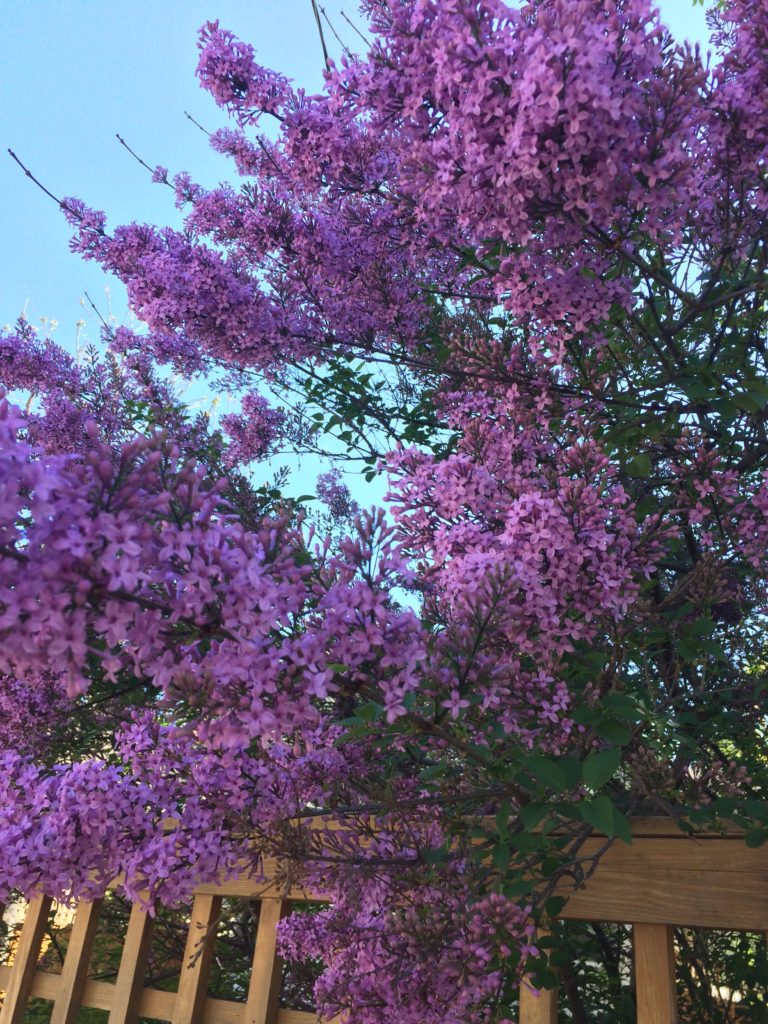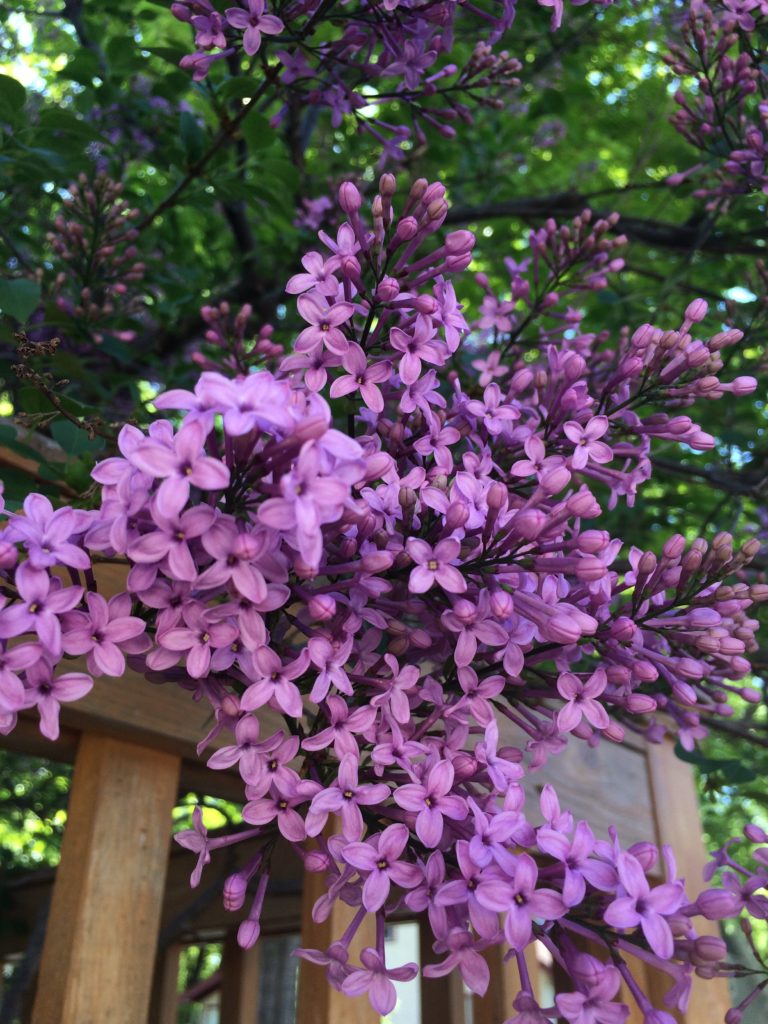Lilacs
The sweet spring air laggardly sighs
up the green hill, over the rise
to the surprise of lilac masses
lining the lane, meeting the sun head-on
then lingering in joyous profusion.
Down the road, swaths of blooms
warm as wax candles, their rich scent
lazily flooding the air with fragrance,
blossoms breaking into somersaults
of scent, the aroma burning down the
hill again, and lifting the skirts of the ladies
strolling along the lane. Heady perfume
infests the nose and sends the senses
submitting to this new assault,
that heralds summer in heady bouquet,
elongating spring and begging us
surrender to its redolent balm.
~ Annette Gagliardi
I have a soft spot in my heart for lilac blossoms. They are delicately robust. They regularly bloom every year from late May to early June—timing depending on the weather. They are fully fragrant. They are spring.
I have the Dwarf Korean Lilacs that bloom just after my neighbor’s Lilacs (the common lilac, Syringa Vulgaris, which blooms in the northern states for 2 weeks), so the “Lilac bloom” is extended for us, an extra week.
Lilacs can be a tree or a shrub. I have the shrub, rather than the tree. When we purchased our home, there were tall Lilac trees in the back yard, but the flowers were at the top of those tall trees, so we could never enjoy them. They were eventually replaced with the shorter, dwarf lilacs that help keep our side yard private.
Lilacs are hardy, easy to grow, and low maintenance. They can grow from 5 to 15 feet tall, depending on the variety. The fragrant flowers are good for cutting and attractive to butterflies. They provide a nice hedgerow and can be pruned by amatures, like me.
Lilacs are one of the few flowers I’m NOT allergic to, so I love them for that reason. When beautiful flowers make you sneeze, they lose some of their appeal. I can cut and bring them into the house without worry that I’ll be sneezing the rest of the day.
Another reason I love them, is that lilacs are edible. Lilac blossoms can be used similarly to other edible flowers. You can put them in a salad, decorate your pudding or top your cake. You can make a tea using either the blossoms or the leaves. I like to incorporate the blossoms in my scone mix and then have lilac tea along with the scones. Another fun way to use the lilac blossom is to place one floweret on the top of each sugar cookie. I use egg white as glue and glaze then sprinkle fine sugar over that. They are delicious.
The medicinal use of Lilacs has been documented since the middle ages. Lilac blossoms used in a tea are known to soothe the stomach or improve digestion. Once the tea is done, you may want to sprinkle 2-3 blossoms over the tea to enjoy the unique lilac scent with every sip.
Lilac Blossom Tea
2 -3 cups lilac flowerets (1 fresh lilac head usually makes 2-3 cups of blossoms)
4 cups boiling water
Sweetener of your choice ( Honey is my preferred choice)
Instructions:
1. Pull the blossoms off the lilac stems. Rinse in cool water & drain well.
2. Heat water to boiling. Add blossoms to water and steep for 5 minutes.
3. Drain tea from blossoms.
4. Pour tea into cups. Add sweetener if needed.
5. Sprinkle 2-3 blossoms on top of the tea for added scent and decoration.

Even if you don’t want to doctor yourself with lilacs, you can use the lilac flowers as natural aromatherapy when taking a bath. Sprinkle your bath water with two handfuls of lilac blossoms and let the heady, springy, and hopeful lilac fragrance melt your thoughts away.
In order to harvest lilacs for culinary or aromatherapy purposes, here are some things you may want to pay attention to.
- Choose plants from an area with no or little exposure to car exhaust
- Harvest dry flowers (not just after a rain)
- Harvest in the morning or right after sunset when flowers are fresh
- Harvest lilac heads with fresh, newly opened blossoms
Symbolization: White lilacs symbolize purity and innocence. Violet lilacs symbolize spirituality. Blue lilacs symbolize happiness and tranquility. Magenta lilacs symbolize love and passion.
Walt Whitman in 1865 wrote an elegy for President Lincoln entitled “When Lilacs Last in the Dooryard Bloom’d.” which is one of the most well-known poems about lilacs. This “Lilacs” elegy is an outpouring of the deep sense of loss that Whitman felt after the assassination of President Abraham Lincoln. The President’s death was a great shock to the poet; it overwhelmed him in a very personal way, hence the somber tone of the poem.
When lilacs last in the dooryard bloom’d
By Walt Whitman
1
When lilacs last in the dooryard bloom’d,
And the great star early droop’d in the western sky in the night,
I mourn’d, and yet shall mourn with ever-returning spring.
Ever-returning spring, trinity sure to me you bring,
Lilac blooming perennial and drooping star in the west,
And thought of him I love.
2
O powerful western fallen star!
O shades of night—O moody, tearful night!
O great star disappear’d—O the black murk that hides the star!
O cruel hands that hold me powerless—O helpless soul of me!
O harsh surrounding cloud that will not free my soul.
(This is a very long poem, so I am providing only the first two stanzas. However, you can view the complete poem by going to the poetry foundation. I site the source below.)
Bibliography:
Article about Walt Whitman’s poem: https://www.bartleby.com/essay/Death-and-Regeneration-in-Walt-Whitmans-Poem-P3JBYWZZTC
When Lilacs Last in the Dooryard Bloom’d by Walt Whitman: https://www.poetryfoundation.org/poems/45480/when-lilacs-last-in-the-dooryard-bloomd
